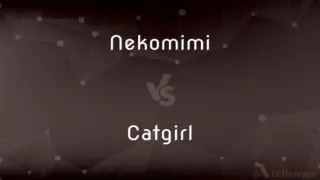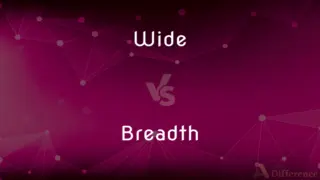Hat vs. Bonnet — What's the Difference?
By Fiza Rafique & Urooj Arif — Updated on April 23, 2024
A hat, a headwear item with various shapes and brims, serves both functional and decorative purposes; a bonnet, specifically designed to cover the head and tie under the chin, is more traditional and protective.

Difference Between Hat and Bonnet
Table of Contents
ADVERTISEMENT
Key Differences
Hats come in a wide variety of styles, including fedoras, caps, and sun hats, each designed for specific uses, such as protection from the sun or as a fashion accessory. In contrast, bonnets are typically designed for women and children, providing full head coverage and often featuring a tie under the chin to keep them in place.
While hats can be made from numerous materials including straw, wool, and leather, depending on their intended use, bonnets are traditionally made from softer materials like cotton or silk, suited for comfort and modesty rather than durability.
Hats often feature a distinct brim which can vary in width, serving to protect the face and eyes from the sun, whereas bonnets might have a small brim or none at all, focusing more on covering the head and framing the face.
The design of hats can be purely aesthetic, making bold fashion statements with embellishments like ribbons or feathers. On the other hand, bonnets often have a more practical design, historically reflecting modesty and femininity, especially in historical or religious contexts.
Both hats and bonnets serve as crucial elements in various cultural and historical costumes, indicating social status or professional roles, but their uses and styles have evolved differently over time.
ADVERTISEMENT
Comparison Chart
Purpose
Functional and decorative, broad utility
Protective, traditional, often feminine
Typical Users
Men and women, all ages
Primarily women and children
Material Varieties
Straw, wool, leather, etc.
Cotton, silk, softer fabrics
Design Features
Wide or no brim, various shapes
Often no brim, ties under the chin
Cultural Significance
Indicates fashion, status, or profession
Historically reflects modesty, femininity
Compare with Definitions
Hat
Used for both practical and fashion purposes.
Her velvet hat was the perfect accessory for her outfit.
Bonnet
Frequently made from soft materials like cotton or silk.
She sewed a cotton bonnet for her newborn niece.
Hat
A covering for the head that often has a brim and can be made of various materials.
He wore a hat to shield himself from the harsh sun.
Bonnet
A soft hat that covers all the hair and ties under the chin, often worn by women.
The baby wore a pink bonnet to the Easter parade.
Hat
Often embellished with items like bands, feathers, or pins.
The hat featured a bright feather on the side.
Bonnet
Often seen in religious or historical contexts.
Bonnets are still worn by women in some conservative religious communities.
Hat
Can be designed without a brim, as in beanies or caps.
His favorite hat is a blue beanie he wears skiing.
Bonnet
Historically used for warmth and modesty rather than fashion.
Her historical costume included a lace bonnet.
Hat
Comes in numerous styles to suit different climates and needs.
For her trip to the desert, she packed a wide-brimmed hat.
Bonnet
Lacks a wide brim and is close-fitting to frame the face.
The portrait showed her wearing a traditional bonnet.
Hat
A hat is a head covering which is worn for various reasons, including protection against weather conditions, ceremonial reasons such as university graduation, religious reasons, safety, or as a fashion accessory.In the past, hats were an indicator of social status. In the military, hats may denote nationality, branch of service, rank or regiment.
Bonnet
A woman's or child's hat tied under the chin and with a brim framing the face.
Hat
A covering for the head, especially one with a shaped crown and brim.
Bonnet
The hinged metal canopy covering the engine of a motor vehicle.
Hat
A head covering of distinctive color and shape worn as a symbol of office.
Bonnet
A cowl on a chimney.
Hat
The office symbolized by the wearing of such a head covering.
Bonnet
An additional canvas laced to the foot of a sail to catch more wind.
Hat
A role or office symbolized by or as if by the wearing of different hats
Wears two hats—one as parent and one as corporate executive.
Bonnet
A hat of cloth or straw, often held in place by ribbons tied under the chin and traditionally worn by women and children.
Hat
To supply or cover with a hat.
Bonnet
(Scots) A brimless cap traditionally worn by men or boys.
Hat
A covering for the head, often in the approximate form of a cone, dome or cylinder closed at its top end, and sometimes having a brim and other decoration.
Bonnet
A removable metal plate over a machine part, such as a valve.
Hat
(figuratively) A particular role or capacity that a person might fill.
Bonnet
Chiefly British The hood of an automobile.
Hat
(figuratively) Any receptacle from which numbers/names are pulled out in a lottery.
Bonnet
A windscreen for a chimney.
Hat
The lottery or draw itself.
We're both in the hat: let's hope we come up against each other.
Bonnet
A cover for a fireplace.
Hat
(video games) A hat switch.
Bonnet
(Nautical) A strip of canvas laced to a fore-and-aft sail to increase sail area.
Hat
The háček symbol.
Bonnet
To put a bonnet on.
Hat
The caret symbol ^.
Bonnet
A type of hat, once worn by women or children, held in place by ribbons tied under the chin.
Hat
(internet slang) User rights on a website, such as the right to edit pages others cannot.
Bonnet
A traditional Scottish woollen brimless cap; a bunnet.
Hat
A student who is also the son of a nobleman (and so allowed to wear a hat instead of a mortarboard).
Bonnet
(by extension) The polishing head of a power buffer, often made of wool.
Hat
(transitive) To place a hat on.
Bonnet
The hinged cover over the engine of a motor car; a hood.
Hat
(transitive) To appoint as cardinal.
Bonnet
(nautical) A length of canvas attached to a fore-and-aft sail to increase the pulling power.
Hat
(intransitive) To shop for hats.
Bonnet
An accomplice of a gambler, auctioneer, etc., who entices others to bet or to bid.
Hat
Hot.
Bonnet
The second stomach of a ruminant.
Hat
A covering for the head; esp., one with a crown and brim, made of various materials, and worn by men or women for protecting the head from the sun or weather, or for ornament.
Bonnet
(historical) A ducat, an old Scottish coin worth 40 shillings.
Hat
Headdress that protects the head from bad weather; has shaped crown and usually a brim
Bonnet
Anything resembling a bonnet (hat) in shape or use.
Hat
An informal term for a person's role;
He took off his politician's hat and talked frankly
Bonnet
A small defence work at a salient angle; or a part of a parapet elevated to screen the other part from enfilade fire.
Hat
Put on or wear a hat;
He was unsuitably hatted
Bonnet
A metallic canopy, or projection, over an opening, as a fireplace, or a cowl or hood to increase the draught of a chimney, etc.
Hat
Furnish with a hat
Bonnet
A frame of wire netting over a locomotive chimney, to prevent escape of sparks.
Bonnet
A roofing over the cage of a mine, to protect its occupants from objects falling down the shaft.
Bonnet
In pumps, a metal covering for the openings in the valve chambers.
Bonnet
(mycology) A mushroom of the genus Mycena.
Bonnet
(transitive) To put a bonnet on.
Bonnet
(obsolete) To take off the bonnet or cap as a mark of respect; to uncover.
Bonnet
To pull the bonnet or cap down over the eyes of.
Bonnet
A headdress for men and boys; a cap.
Bonnet
A soft, elastic, very durable cap, made of thick, seamless woolen stuff, and worn by men in Scotland.
And p i s and bonnets waving high.
Bonnet
A covering for the head, worn by women, usually protecting more or less the back and sides of the head, but no part of the forehead. The shape of the bonnet varies greatly at different times; formerly the front part projected, and spread outward, like the mouth of a funnel.
Bonnet
Anything resembling a bonnet in shape or use
Bonnet
An additional piece of canvas laced to the foot of a jib or foresail in moderate winds.
Bonnet
The second stomach of a ruminating animal.
Bonnet
An accomplice of a gambler, auctioneer, etc., who entices others to bet or to bid; a decoy.
Bonnet
The metal cover or shield over the motor; predominantly British usage. In the U.S. it is called the hood.
Bonnet
To take off the bonnet or cap as a mark of respect; to uncover.
Bonnet
A hat tied under the chin
Bonnet
Protective covering consisting of a metal part that covers the engine;
There are powerful engines under the hoods of new cars
The mechanic removed the cowling in order to repair the plane's engine
Bonnet
Dress in a bonnet
Common Curiosities
What are some common materials used to make hats?
Common materials for hats include straw, wool, felt, and leather.
How do hats vary in design?
Hats vary widely in design, including differences in brim width, material, and additional decorative elements.
What is the main purpose of a bonnet?
The main purpose of a bonnet is to provide head coverage, historically for warmth and modesty, especially for women and children.
Why might someone choose a bonnet over a hat?
Someone might choose a bonnet for its traditional aesthetic, full head coverage, or for its historical significance in costume.
What kind of hat is suitable for formal occasions?
Formal occasions typically call for dress hats like fedoras, trilbies, or even top hats depending on the level of formality.
What defines a hat?
A hat is a head covering that can have various brim sizes and is made from diverse materials for functional or fashion purposes.
Do bonnets provide any practical benefits today?
Today, bonnets can offer practical benefits such as warmth, especially in cooler climates, and are used in settings where preserving traditional dress is important.
Can men wear bonnets?
Traditionally, bonnets are worn by women and children, but in historical reenactments or certain cultures, men might also wear bonnet-style headgear.
Which is more versatile, a hat or a bonnet?
Hats are generally more versatile due to the wide range of styles and materials suitable for various occasions and weather conditions.
How do hats and bonnets differ in terms of cultural significance?
Hats have broad cultural significance indicating status or profession, while bonnets are more closely tied to historical and feminine modesty contexts.
Are bonnets still fashionable today?
While not mainstream, bonnets appear in fashion circles that value vintage or historical styles and are prominent in certain religious or cultural communities.
How has the function of bonnets changed over time?
Historically, bonnets provided warmth and modesty but now they are more commonly seen in historical reenactments or among specific cultural groups.
How does the cultural relevance of bonnets compare to that of hats?
Bonnets have a specific cultural relevance tied to historical dress and modesty, whereas hats have broader relevance across many aspects of society and history.
Are there any specific cultural events where wearing a bonnet is customary?
Yes, cultural events that focus on historical reenactment or periods like the Victorian era often feature bonnets as part of the customary attire.
What type of hat is best for sun protection?
Hats with wide brims, such as sun hats or Panama hats, are best for sun protection.
Share Your Discovery

Previous Comparison
Nekomimi vs. Catgirl
Next Comparison
Wide vs. BreadthAuthor Spotlight
Written by
Fiza RafiqueFiza Rafique is a skilled content writer at AskDifference.com, where she meticulously refines and enhances written pieces. Drawing from her vast editorial expertise, Fiza ensures clarity, accuracy, and precision in every article. Passionate about language, she continually seeks to elevate the quality of content for readers worldwide.
Co-written by
Urooj ArifUrooj is a skilled content writer at Ask Difference, known for her exceptional ability to simplify complex topics into engaging and informative content. With a passion for research and a flair for clear, concise writing, she consistently delivers articles that resonate with our diverse audience.















































